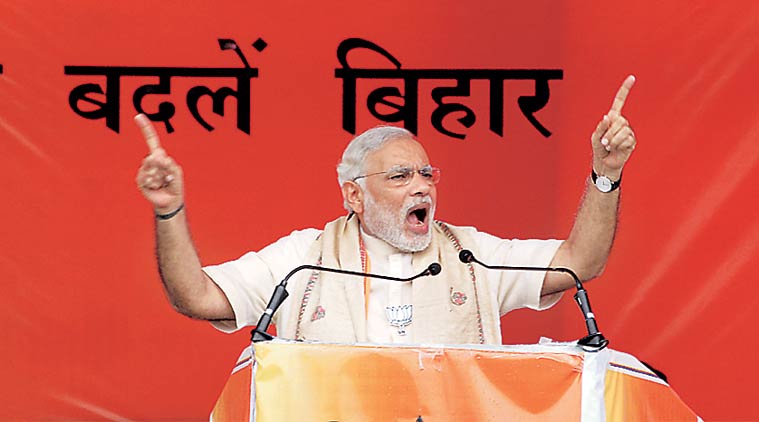- India
- International
A package to Bihar
The state needs a stimulus. Only the Centre can provide it.
 Narendra Modi at the Saharsa rally. (Express Photo by: Prashant Ravi)
Narendra Modi at the Saharsa rally. (Express Photo by: Prashant Ravi)
In a recent trip to poll-bound Bihar, a complaint we heard more than once was: “If the prime minister is so powerful, what’s he doing for Bihar? How can he have election rallies without any ‘package’ for the state?” This was just a week before the PM announced Rs 1,25,000 crore of investments in the state.
Even a cursory look through the list suggests that many of the projects included in the list were already in the works: national highway projects worth Rs 10,000 crore are in the bidding stage, implying most of the necessary clearances are through and land acquisition is done, and in three years and a bit, they should be complete. Most of the planned spend on the doubling/ tripling/ electrification of railway lines, the Rs 17,000 crore Barauni refinery expansion, the Rs 4,100 crore LPG pipeline expansion, the Rs 10,000 crore Buxar Power Plant, or even rural electrification, were projects announced by the government earlier this year. Given the granularity of some of these projects, it is hard to imagine that they could be created at short notice. Indeed, it would be highly irresponsible if they were.
So what the PM did was combine the projects already announced by various departments of his government into one combined number. In these times of information overload, it’s hard to get anyone’s attention, particularly when it comes to money; after all, billions and millions and thousands of crores often feature in the headlines. For people to notice and the “commentariat” to be jolted into response, a “big” number was needed — and it was delivered. It made a big splash.
As it should have: Rs 1,25,000 crore is nearly 30 per cent of Bihar’s GDP, and it is all investment, no freebies. That these projects were announced separately over the past six to eight months does not dilute their value. Economists focus on the “fiscal multiplier” of government spending, that is, for every rupee spent, how many rupees of incremental output gets generated. Investments have the highest multiplier and freebies often the lowest. This should, therefore, boost Bihar’s growth meaningfully. But to get a better sense of how much, one must get into the details.
Slightly less than half, or about Rs 55,000 crore, is to upgrade 2,775 km of national highways. No one can deny their necessity. Bihar has close to the lowest density of national highways in India (measured by km per person) and, worse, only 18 per cent of these are four-laned or wider, much lower than the national average. Take, for example, the Rs 5,000 crore for a second four-laned bridge over the Ganga. The current one, the famous 5.5 km-long Mahatma Gandhi Setu, remains the only major road link connecting north Bihar to Patna, and any commercial airport. It is 33 years old, a period in which Bihar’s population has more than doubled, let alone the traffic, which is now the stuff of legend. Two years ago when I was on that bridge, two of the lanes had been blocked in sections for repairs (as they often are). So it was one functional lane north, and another south. On the latter, one cycle-rickshaw-wallah was pedalling away furiously, setting the pace for all the buses and high-powered SUVs behind him. If I had any doubts about why Bihar competes with Somalia in its per capita GDP, that one scene dispelled them. So yes, that second bridge is necessary. How long it takes is another question.

Then there is about Rs 14,000 crore for rural roads under the Pradhan Mantri Gram Sadak Yojana (PMGSY). Rural roads take much less time to build, so given that the average annual expenditure in Bihar under the scheme has been two to three thousand crore, this is likely a multi-year allocation. One wouldn’t be surprised, however, if there is an acceleration in spending. Reliable data on this is hard to find, but despite the 9,000 villages connected by all-weather roads under the PMGSY, more than half of Bihar habitations are still waiting for all-weather roads.
The Rs 6,000 crore allocated for rural electrification, together with the state’s own contribution, and some help from the ADB, will help further what is nothing short of a revolution underway in the electrification of Bihar, as a “dark” state begins to light up. In 2011, only a sixth (16 per cent) of Bihar’s households had access to electricity (we are not counting how many hours yet), and the remaining five-sixths had no wires going into their houses. Current electrification is at 45 per cent, and nearly 11 lakh (5.5 per cent of the total) households have been electrified between April and June this year. The state expects to reach 70 per cent-plus in another one and a half years, and 100 per cent in 3.5 years. One cannot over-emphasise the importance of these changes for productivity and growth.
Similarly, the need for a new airport at Patna (discussed since at least 2012) and investment in new tourism circuits around historic places is undeniable. Thus, these seem to be well-planned, productive and necessary projects. Their funding should also not be a challenge. But this does raise one fundamental political question: Should the Centre decide which state gets which project? Some might suggest there is a
risk it could be perceived as using Central funds to help the ruling party’s Bihar election prospects.
Bihar is a fascinating case study in development. Its “state”, that is, the administrative machinery, is under-developed. The number of state government employees (adjusted for population) in Bihar is nearly a fifth of the national average. It lacks police personnel, teachers, urban administrators, etc. If you have 710 police personnel per million people versus the national average of 1,380 (which itself is among the lowest in the world), it is hard to have good law and order. And if you have poor law and order, you will not have investors. State government spending per person is only 60 per cent of the national average, as the government cannot afford to spend more without falling into a debt trap.
To break out of this vicious cycle, we believe the state needs a stimulus, and only the Centre can provide it. Kickstarting the economy of Bihar, which has as many people as Mexico and more low-hanging fruit than litchis in Muzaffarpur, could stimulate the broader Indian economy as well. The economic returns on the government’s investments (the refinery and power plant investments aside) seem quite attractive. (Disclaimer: the author is from Bihar.) The only uncertainty is the execution timeline.
The writer is India equity strategist, Credit Suisse.
EXPRESS OPINION
More Explained
Apr 26: Latest News
- 01
- 02
- 03
- 04
- 05











































